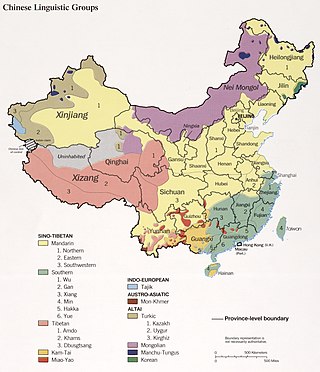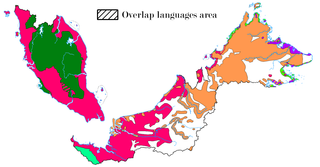Related Research Articles

There are several hundred languages in China. The predominant language is Standard Chinese, which is based on central Mandarin, but there are hundreds of related Chinese languages, collectively known as Hanyu, that are spoken by 92% of the population. The Chinese languages are typically divided into seven major language groups, and their study is a distinct academic discipline. They differ as much from each other morphologically and phonetically as do English, German and Danish, but meanwhile share the same writing system (Hanzi) and are mutually intelligible in written form. There are in addition approximately 300 minority languages spoken by the remaining 8% of the population of China. The ones with greatest state support are Mongolian, Tibetan, Uyghur and Zhuang.

Language immersion, or simply immersion, is a technique used in bilingual language education in which two languages are used for instruction in a variety of topics, including math, science, or social studies. The languages used for instruction are referred to as the L1 and the L2 for each student, with L1 being the student's native language and L2 being the second language to be acquired through immersion programs and techniques. There are different types of language immersion that depend on the age of the students, the classtime spent in L2, the subjects that are taught, and the level of participation by the speakers of L1.
Monoglottism or, more commonly, monolingualism or unilingualism, is the condition of being able to speak only a single language, as opposed to multilingualism. In a different context, "unilingualism" may refer to a language policy which enforces an official or national language over others.

Sinophone, which means "Chinese-speaking", typically refers to an individual who speaks at least one variety of the Chinese language. Academic writers often use the term Sinophone in two definitions: either specifically "Chinese-speaking populations where it is a minority language, excluding Mainland China, Hong Kong, Macau, and Taiwan" or generally "Chinese-speaking areas, including where it is an official language". Many authors use the collocation Sinophone world or Chinese-speaking world to mean the Chinese-speaking world itself or the distribution of the Chinese diaspora outside of Greater China.

Cantonese is a language within the Chinese (Sinitic) branch of the Sino-Tibetan languages originating from the city of Guangzhou and its surrounding area in Southeastern China. It is the traditional prestige variety of the Yue Chinese dialect group, which has over 80 million native speakers. While the term Cantonese specifically refers to the prestige variety, it is often used to refer to the entire Yue subgroup of Chinese, including related but largely mutually unintelligible languages and dialects such as Taishanese.
Language shift, also known as language transfer or language replacement or language assimilation, is the process whereby a speech community shifts to a different language, usually over an extended period of time. Often, languages that are perceived to be higher status stabilise or spread at the expense of other languages that are perceived by their own speakers to be lower-status. An example is the shift from Gaulish to Latin during the time of the Roman Empire.

Multilingualism is the use of more than one language, either by an individual speaker or by a group of speakers. It is believed that multilingual speakers outnumber monolingual speakers in the world's population. More than half of all Europeans claim to speak at least one language other than their mother tongue; but many read and write in one language. Multilingualism is advantageous for people wanting to participate in trade, globalization and cultural openness. Owing to the ease of access to information facilitated by the Internet, individuals' exposure to multiple languages has become increasingly possible. People who speak several languages are also called polyglots.
The Speak Mandarin Campaign is an initiative by the government of Singapore to encourage the Singaporean Chinese population to speak Standard Mandarin Chinese, one of the four official languages of Singapore. Launched on 7 September 1979 by then Prime Minister Lee Kuan Yew and organised by the Promote Mandarin Council, the SMC has been an annual event promoting the use of Mandarin.

A multitude of languages are used in Singapore. It consists of several varieties of languages under the families of the Austronesian languages, Dravidian languages, Indo-European languages and Sino-Tibetan languages. According to the Constitution of Singapore, the national language of Singapore is Malay, which plays a symbolic role, as Malays are constitutionally recognised as the indigenous peoples of Singapore, and it is the government's duty to protect their language and heritage. The constitution also states that the four commonly used languages of Singapore are English, Chinese, Malay and Tamil, with the lingua franca between Singaporeans of different races being English, the de facto main language. Singaporeans often speak Singlish among themselves. Singlish is an informal, colloquial form of English that is used in Singapore. Linguists define it as Singapore Colloquial English.
Minority (non-Japanese) students can be found throughout the entire Japanese education system. An incomplete list of possible cultural and or language minorities represented in Japanese schools include:
Dual language is a form of education in which students are taught literacy and content in two languages. Most dual language programs in the United States teach in English and Spanish, but programs increasingly use a partner language other than Spanish, such as Arabic, Chinese, French, Hawaiian, Japanese, or Korean. Dual language programs use the partner language for at least half of the instructional day in the elementary years.
Singaporean Mandarin is a variety of Mandarin Chinese spoken natively in Singapore. It is one of the four official languages of Singapore along with English, Malay and Tamil.

The indigenous languages of Malaysia belong to the Mon-Khmer and Malayo-Polynesian families. The national, or official, language is Malay which is the mother tongue of the majority Malay ethnic group. The main ethnic groups within Malaysia are the Malay people, Han Chinese people and Tamil people, with many other ethnic groups represented in smaller numbers, each with its own languages. The largest native languages spoken in East Malaysia are the Iban, Dusunic, and Kadazan languages. English is widely understood and spoken within the urban areas of the country; the English language is a compulsory subject in primary and secondary education. It is also the main medium of instruction within most private colleges and private universities. English may take precedence over Malay in certain official contexts as provided for by the National Language Act, especially in the states of Sabah and Sarawak, where it may be the official working language. Furthermore, the law of Malaysia is commonly taught and read in English, as the unwritten laws of Malaysia continues to be partially derived from pre-1957 English common law, which is a legacy of past British colonisation of the constituents forming Malaysia. In addition, authoritative versions of constitutional law and statutory law are continuously available in both Malay and English.
Practices in language education vary significantly by region. Firstly, the languages being learned differ; in the United States, Spanish is the most popular language to be learned, whereas the most popular languages to be learned in Australia are German, French, Italian and Mandarin Chinese. Also, teaching methods tend to differ by region. Language immersion is popular in some European countries, but is not used very much in the United States.
In Singapore, language planning is associated with government planning. In this top-down approach, the government influences the acquisition of languages and their respective functions within the speech community through the education system. Language planning aims to facilitate effective communication within the speech community, which can result in a language shift or language assimilation. The goals of language planning are very much dependent on the political and social forces present in Singapore during two distinct periods: Colonisation by the British and the Post-Independence period after 1965.
Singapore embraces an English-based bilingual education system. Students are taught subject-matter curriculum with English as the medium of instruction, while the official mother tongue of each student - Mandarin Chinese for Chinese, Malay for Malays and Tamil for South Indians – is taught as a second language. Additionally, Higher Mother Tongue (HMT) is offered as an additional and optional examinable subject to those with the interest and ability to handle the higher standards demanded by HMT. The content taught to students in HMT is of a higher level of difficulty and is more in-depth so as to help students achieve a higher proficiency in their respective mother tongues. The choice to take up HMT is offered to students in the Primary and Secondary level. Thereafter, in junior colleges, students who took HMT at the secondary level have the choice to opt out of mother tongue classes entirely. Campaigns by the government to encourage the use of official languages instead of home languages have been largely successful, although English seems to be becoming the dominant language in most homes. To date, many campaigns and programmes have been launched to promote the learning and use of mother tongue languages in Singapore. High ability students may take a third language if they choose to do so.

Chinese languages, mostly Cantonese, are collectively the third most-spoken language in the United States, and are mostly spoken within Chinese-American populations and by immigrants or the descendants of immigrants, especially in California and New York. Around 2004, over 2 million Americans spoke varieties of Chinese, with Mandarin becoming increasingly common due to immigration from mainland China and to some extent Taiwan. Despite being called dialects or varieties, Cantonese, Taishanese, and Mandarin etc. are not mutually intelligible. When asked census forms and surveys, respondents will only answer with "Chinese".
The following is a list of bilingual education by country or region.
During the martial law period in Taiwan, a monolingual policy was implemented in Taiwan by the Kuomintang. The policy was formulated as a political goal to unite the island. However, the demotion of prior local languages into "dialects" across cultural and educational landscapes resulted in a pushback of the policy and eventually rescinded as Taiwan democratized.
Marcia Jarmel is a director, producer, and long-standing member of the Bay Area documentary community. In 1994, she co-founded the San Francisco-based production company, PatchWorks Films, with husband-collaborator Ken Schneider. She has directed, produced, and managed impact for their award-winning slate of films ever since. Jarmel made her directorial debut with The Return of Sarah’s Daughters, which premiered at the San Francisco Jewish Film Festival in 1997. She has been honored with residencies with BAVC Media Maker, Working Films, SFFilmm, and Kopkind Colony. She most recently co-directed and co-produced, Los Hermanos/The Brothers, which won Best Documentary at the WoodStock Film Festival and broadcast on PBS in 2021.
References
- ↑ "Documentary: Speaking in Tongues - Four kids. Four languages. One city. One World". bilingualparenting.com. Retrieved 2016-11-30.
- ↑ "Bilingual Education Pays Off, New Documentary Says - New America Media". newamericamedia.org. Retrieved 2016-12-20.
- 1 2 "Latin American Herald Tribune - Documentary Explores Importance of Bilingualism in U.S." www.laht.com. Retrieved 2016-12-20.
- ↑ "Ling-chi Wang". aaads.berkeley.edu. Retrieved 2016-12-20.
- ↑ "'Speaking in Tongues' documentary to be shown during Arts Fest". Penn State University. Retrieved 2016-12-20.